Practice Opponents
More actions
The Practice Opponents feature allows you to play out positions against a variety of analytical and database-based opponents. Each opponent represents a unique training philosophy — from pure engine strength to human-style statistics — helping you refine your repertoire and decision-making through live play.
You can configure each opponent with custom parameters such as depth, move visibility, centipawn tolerance, or rating range. This flexibility allows you to simulate realistic conditions, test your memory, or strengthen your calculation skills.
Stockfish
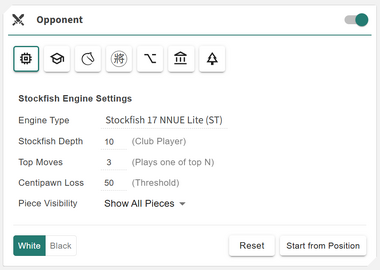
The Stockfish opponent uses the integrated chess engine to generate precise, tactical, and unforgiving play. It’s ideal for testing your preparation against perfect calculation.
Available settings:
- ◦ Engine Type: Choose from available Stockfish builds for performance and speed
- ◦ Depth: Controls how deeply Stockfish searches for moves (higher = stronger)
- ◦ Top Moves (PV Count): Determines how many of the best moves are considered before one is selected
- ◦ Centipawn Loss Filter: Default 50 — only moves within 50 centipawns of the top move are considered
- ◦ Piece Visibility: Hide pieces to practice blindfold or partial-vision chess
Why use Stockfish:
- + Perfect for stress-testing your opening choices under precise, engine-level play
- + Helps identify tactical weaknesses and punish inaccuracies in real-time
- + Great for developing deep calculation skills and defensive precision
Masters Database
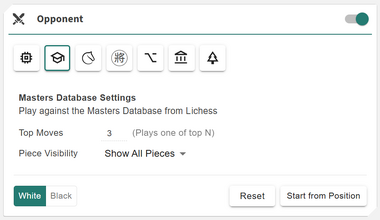
The Masters Database opponent replicates decisions made by top professional players, offering a realistic and theory-driven experience.
Available settings:
- ◦ Top Moves: Number of candidate moves drawn from the master game archive
- ◦ Piece Visibility: Optionally obscure your pieces for advanced training
Why use Masters Database:
- + Practice your repertoire against human-style precision and real opening theory
- + Great for learning typical plans and ideas used by professionals
Lichess Database
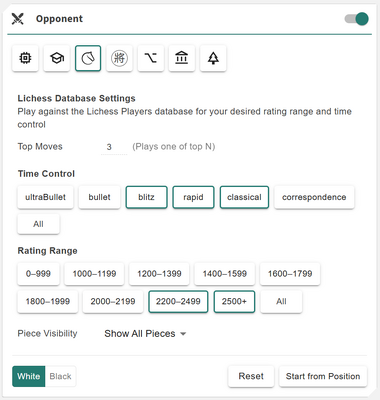
The Lichess Database opponent bases its moves on real online games from millions of players across all rating levels.
Available settings:
- ◦ Top Moves: How many database moves to consider
- ◦ Time Controls: Filter moves by Classical, Blitz, Rapid, or Correspondence formats
- ◦ Rating Range: Choose the opponent pool by rating level
- ◦ Piece Visibility: Optional blindfold training
Why use Lichess Database:
- + Experience realistic online-style play and unpredictable human patterns
- + Perfect for testing your lines against practical human-level choices
ChessDB
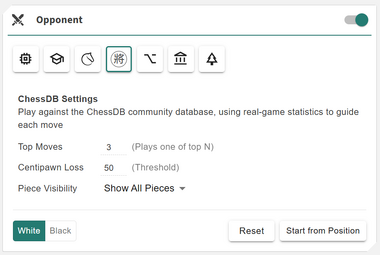
The ChessDB opponent uses a large-scale global database combining both human and engine games, offering a balanced mix of tactical precision and statistical realism.
Available settings:
- ◦ Top Moves: Number of moves to consider
- ◦ Centipawn Loss: Filter out suboptimal moves based on centipawn difference
- ◦ Piece Visibility: Optional blindfold or visualization training
Why use ChessDB:
- + Combines realistic human statistics with engine-level filtering
- + Excellent for spotting trends and testing move soundness
Your Repertoires
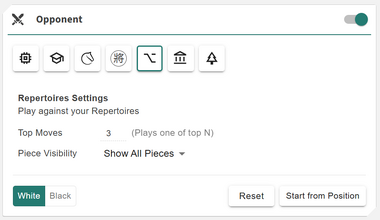
The Your Repertoires opponent plays directly from your own prepared lines, simulating a “mirror match” against your studied repertoire.
Available settings:
- ◦ Top Moves: Number of repertoire moves to choose from
- ◦ Piece Visibility: Optional visualization training
Why use Your Repertoires:
- + Practice directly against your own preparation to identify weak branches
- + Reinforces memory and familiarity with your personal repertoire choices
My Library Moves
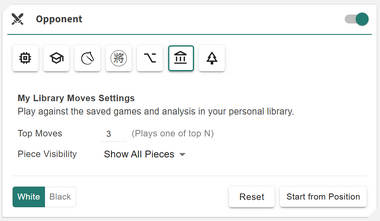
The My Library Moves opponent selects from your saved game or position library, replaying patterns drawn from your personal study material.
Available settings:
- ◦ Top 3 Moves: Considers your three most common continuations
- ◦ Centipawn Loss: Filters moves by quality threshold
- ◦ Piece Visibility: Hide pieces to practice blindfold or partial-vision chess
Why use My Library Moves:
- + Test your own historical preferences and improve your consistency
- + Great for building self-awareness around your tendencies in specific structures
Reference Tree
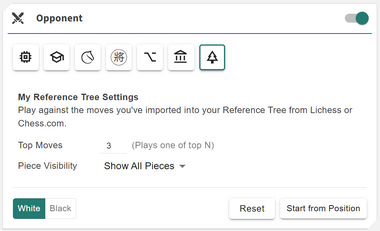
The Reference Tree opponent draws from your reference move tree, combining statistical guidance with real repertoire structure.
Available settings:
- ◦ Top 3 Moves: Uses the best three reference moves from the position
- ◦ Centipawn Loss: Filters out statistically weak or inaccurate continuations
- ◦ Piece Visibility: Hide pieces to practice blindfold or partial-vision chess
Why use Reference Tree:
- + Practice within your broader statistical preparation for realistic decision-making
- + Reinforces opening familiarity using real frequency data and practical results
Maia Engine
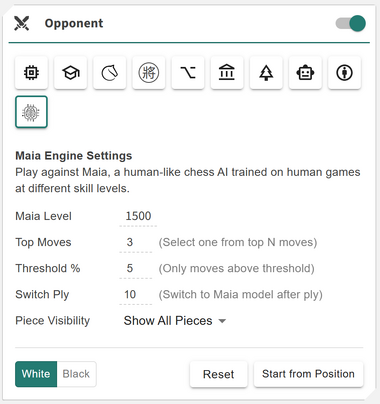
Subscriber Only - The Maia Engine opponent simulates human decision-making by predicting moves made by real players at different skill levels. Instead of calculating perfect engine lines, Maia selects moves based on how humans actually play, creating a natural and realistic training partner.
Available settings:
- ◦ Maia Level: Choose from rated models (e.g., 1100, 1500, 1900) based on how strong and human-like you want the opponent to be
- ◦ Top N Moves: Restrict selection to the top N human-predicted moves (or broaden it for more variety)
- ◦ Threshold %: Only allow moves above a chosen probability threshold
- ◦ Switch Ply: Choose the ply where we stop using the opening book and switch to pure Maia.
- ◦ Piece Visibility: Hide pieces to practice blindfold or partial-vision chess
Why use Maia Engine:
- + Train against realistic human-style moves rather than perfect engine lines
- + Great for understanding typical mistakes, habits, and tendencies at your opponents’ skill levels
- + Helps bridge the gap between studying theory and playing real human opponents
